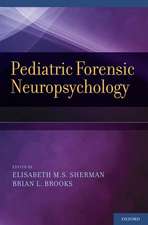Neuropsychology of Asians and Asian-Americans: Practical and Theoretical Considerations: Issues of Diversity in Clinical Neuropsychology
Editat de J. Mark Davis, Rik Carl D'Amatoen Limba Engleză Hardback – 20 aug 2013
Practical and Theoretical Considerations
J. Mark Davis and Rik Carl D'Amato, editors
The challenge of cultural competence for health providers is more than the recognition of other ethnicities: it entails the balancing of group and individual factors to apply relevant information in diagnostic and therapeutic settings. Particularly in need of culturally appropriate services are Asians and Asian Americans, populations that are diverse, growing, and underserved by Asian practitioners.
Neuropsychology with Asians and Asian Americans takes cultural neuroscience to new levels in its variety and usefulness. Focusing on the largest groups of Far East and Southeast Asian descent, this leading-edge reference examines the influence of culture on psychological processes and identifies sociocultural factors as they influence neurological aspects of client presentation. This expert coverage goes beyond well-known constructs of "collectivism" and "family orientation" toward establishing an evidence base crucial to understanding, assessing, and treating Asian and Asian American clients, including:
- Linguistic factors and language assessment of Asians.
- Society and acculturation in Asian and Asian American communities
- Mental illness from Asian and Asian American perspectives.
- Understanding cognitive differences across the lifespan: comparing Eastern and Western cultures
- Clinical interviews and qualitative assessment with Asian clients
- Neuropsychological test selection with Asian clients
Unique in its scope and detail, Neuropsychology with Asians and Asian Americans is a necessary resource for neuropsychologists and rehabilitation specialists as well as social workers and clinical, counseling, and school psychologists.
| Toate formatele și edițiile | Preț | Express |
|---|---|---|
| Paperback (1) | 636.30 lei 6-8 săpt. | |
| Springer – 14 aug 2015 | 636.30 lei 6-8 săpt. | |
| Hardback (1) | 642.51 lei 6-8 săpt. | |
| Springer – 20 aug 2013 | 642.51 lei 6-8 săpt. |
Preț: 642.51 lei
Preț vechi: 755.88 lei
-15% Nou
Puncte Express: 964
Preț estimativ în valută:
122.98€ • 133.63$ • 103.37£
122.98€ • 133.63$ • 103.37£
Carte tipărită la comandă
Livrare economică 21 aprilie-05 mai
Preluare comenzi: 021 569.72.76
Specificații
ISBN-13: 9781461480747
ISBN-10: 1461480744
Pagini: 212
Ilustrații: XV, 193 p. 4 illus.
Dimensiuni: 155 x 235 x 17 mm
Greutate: 0.48 kg
Ediția:2014
Editura: Springer
Colecția Springer
Seria Issues of Diversity in Clinical Neuropsychology
Locul publicării:New York, NY, United States
ISBN-10: 1461480744
Pagini: 212
Ilustrații: XV, 193 p. 4 illus.
Dimensiuni: 155 x 235 x 17 mm
Greutate: 0.48 kg
Ediția:2014
Editura: Springer
Colecția Springer
Seria Issues of Diversity in Clinical Neuropsychology
Locul publicării:New York, NY, United States
Public țintă
ResearchCuprins
Chapter 1 Overview of Issues Related to Serving Asian and Asian American Clients.-1.1 Introduction.- 1.2 Cultural Competence.- 1.3 Who are “Asian Americans”?.- 1.4 Cultural variables that influence neuropsychological services.- 1.4.1 Client Characteristics.- 1.4.2 Variables related to tests and test batteries.- 1.5 Conclusions.- 1.6 References.- Chapter 2 Ethical considerations in neuropsychological assessment of Asian heritage clients.- 2.1 Introduction.- 2.2 The importance of values in cross-cultural neuropsychology practice.- 2.3 Culturally invariant ethical and moral principles.- 2.4 Internationalization of psychological ethics.- 2.5 Neuropsychology and the Interpreter.- 2.5.1 Use of interpreters.- 2.5.2 Ethical duties of the Interpreter.- 2.6 Some Issues Pertaining to Specific Ethical Standards.- 2.6.1 Competency.- 2.6.2 Informed consent and confidentiality.- 2.6.3 Assessment procedures.- 2.7 Some summary considerations.- 2.8 References.- Chapter 3 Linguistic Factors and Language Assessment of Asians.- 3.1 Introduction.- 3.2 Theoretical foundations in linguistic science.- 3.2.1 The Language Acquisition Device (LAD).- 3.2.2 The Critical Period Hypothesis.- 3.2.3 Language and linguistic features defined.- 3.2.4 Native versus non-native languages.- 3.2.5 L1 interference and transfer.- 3.2.6 Interlanguage and fossilization.- 3.3 Features of English that frequently pose problems to L2 speakers.- 3.3.1 Pronunciation: Consonants.- 3.3.2 Pronunciation: Vowels.- 3.3.3 Pronunciation: Supra-segmental phonology.- 3.3.4 Lexicon: Native and borrowed vocabulary.- 3.3.5 Lexicon: Noun characteristics.- 3.3.6 Morpho-syntax: Prepositions.- 3.3.7 Morphosyntax: Subject/verb agreement.- 3.4 Case studies of two Asian languages.- 3.4.1 Case study: Chinese.- 3.4.2 Case Study: Japanese.- 3.5 Testing English proficiency.- 3.6 Asian Englishes.- 3.7 Conclusions.- 3.8 References.- Chapter 4 Society and Acculturation in Asian American Communities.- 4.1 AsianPhilosophies and Religions.- 4.1.1 Confucianism.- 4.1.2 Taoism.- 4.1.3 Buddhism.- 4.2 Values, Beliefs, Emotions, and Interpersonal Behaviors of Asians.- 4.2.1 Valuing learning and education.- 4.2.2 Family orientation.- 4.2.3 Interdependency.- 4.2.4 Power distance.- 4.2.5 Face saving.- 4.2.6 Indirectness in communication.- 4.2.7 Avoid going to extremes and moderate emotions.- 4.2.8 Acceptance of contradictions, and mixed emotions.- 4.2.9 Suppression of emotional expression.- 4.3 Holistic thinking and test performance.- 4.4 Response biases.- 4.5 Acculturation.- 4.5.1 Acculturation Theory and Measurement.- 4.5.2 Acculturation Assessment.- 4.6 Conclusions.- 4.7 References.- Chapter 5 Mental Illness from an Asian American Perspective.- 5.1 Introduction.- 5.2 Prevalence rate of Mental Illness in Asia.- 5.3 Nosology and the medical model.- 5.4 The role of Eastern philosophies.- 5.5 Morita Therapy.- 5.6 Caveat.- 5.7 References.- Chapter 6 Understanding Differences in Cognition across the Lifespan: Comparing Eastern and Western Cultures.- 6.1 Introduction.- 6.2 Developmental Differences in Children and Adolescents.- 6.2.1 Academic Achievement.- 6.2.2 Cognitive Functioning.- 6.2.3 Social Cognition.- 6.2.4 Adaptive Functioning.- 6.2.5 Additional Influences on Culture-Based Differences in Cognitive Development.- 6.3 Differences in Cognition in Mature Adults.- 6.3.1 Academic Achievement.- 6.3.2 Cognitive Functioning.- 6.3.3 Visual Perception.- 6.3.4 Social Cognition.- 6.3.5 Influences Related to Individualism vs. Collectivism.- 6.4 Differences in cognition in older adults.- 6.5 Influence of Acculturation, Language, and Related Factors on Test Performance.- 6.6 Conclusions.- 6.7 References.- Chapter 7 Understanding the Neuroscience of Clients with Asian Heritage. 7.1 Cultural Neuroscience.- 7.2 The Influence of Culture on Psychological Processes.- 7.2.1 Perception.- 7.2.3 Attention.- 7.2.4 Arithmetic.- 7.2.5 Language.- 7.2.6 Independence and Interdependence.- 7.2.7 Emotion and Emotion Regulation.- 7.2.8 Conclusion.- 7.3 Structural and Functional MRI.- 7.3.1 Structural MRI and Ethnicity.- 7.3.2 Functional MRI and Ethnicity.- 7.4 Conclusion.- 7.5 References.- Chapter 8 Clinical Interviewing and Qualitative Assessment with Asian Heritage Clients.- 8.1 Introduction.- 8.2 Socio-cultural factors influencing the presentation of Asian Americans.- 8.2.1 Perception of psychological problems and services.- 8.2.2 The collectivist orientation and family system.- 8.2.3 Emphasis on modesty and courtesy.- 8.2.4 Respect for authority.- 8.3 Strategies in working with Asian Americans in neuropsychological interviews and qualitative assessment.- 8.3.1 General objectives in conducting a culturally-sensitive clinical interview and qualitative assessment.- 8.3.2 Assessing the need for a referral and making one when appropriate.- 8.3.3 Thorough briefing of the interpreter, if using one is absolutely necessary.- 8.3.4 Investing an effort in getting information and soliciting support from the family in rehabilitation plans.- 8.3.5 Taking the time to explain the neuropsychological evaluation.- 8.3.6 Working with the role-bound respect for authority.- 8.3.7 Creating an open environment for honest communication while maintaining harmony.- 8.3.8 Differentiating aptitude, opportunities, and cultural expectations in assessing attainment.- 8.3.9 Asking for clarification and cultural education from the patient and the family.- 8.3.10 Prudent adaptation of standardized tests to provide qualitative data.- 8.3.11 Development of a more flexible approach in neuropsychological assessment.- 8.4 Conclusions.- 8.5 Acknowledgement.- 8.6 References.- Chapter 9 Neuropsychological Test Selection with Clients who are Asian.- 9.1 Test Selection Issues for Neuropsychological Assessment.- 9.2 Language.- 9.2.1 Language Proficiency.- 9.2.2 Language Minimized/Nonverbal Tests.- 9.2.3 Adaptation of Existing Tests with Language Loading.- 9.2.4 Use of Interpreters as a Modification.- 9.3 Acculturation.- 9.3.1 Culture Specific Issues.- 9.4 Tests Standardized with or Developed for Asian Populations.- 9.5 Discussion and Conclusion.- 9.6 References.- Chapter 10 What Do We Need to Know before Serving Asian and Asian American Clients?.- 10.1 “Take home” points.- 10.2 Importance of a multimethod approach.- 10.3 Conclusions.- 10.4 References.-
Recenzii
From the reviews:
“The contributing authors address the most significant issues related to the neuropsychological assessment of Asian clients … . Although the book is written for the neuropsychologist, it is relevant to the assessment of Asian clients in general. … The book provides tremendously useful information about Asians and Asian Americans but also describes how to use that information to understand the individual.” (Vincent G. Tsushima, PsycCRITIQUES, Vol. 59 (17), 2014)
“The contributing authors address the most significant issues related to the neuropsychological assessment of Asian clients … . Although the book is written for the neuropsychologist, it is relevant to the assessment of Asian clients in general. … The book provides tremendously useful information about Asians and Asian Americans but also describes how to use that information to understand the individual.” (Vincent G. Tsushima, PsycCRITIQUES, Vol. 59 (17), 2014)
Textul de pe ultima copertă
Neuropschology with Asians and Asian Americans
Practical and Theoretical Considerations
J. Mark Davis and Rik Carl D'Amato, editors
The challenge of cultural competence for health providers is more than the recognition of other ethnicities: it entails the balancing of group and individual factors to apply relevant information in diagnostic and therapeutic settings. Particularly in need of culturally appropriate services are Asians and Asian Americans, populations that are diverse, growing, and underserved by Asian practitioners.
Neuropsychology with Asians and Asian Americans takes cultural neuroscience to new levels in its variety and usefulness. Focusing on the largest groups of Far East and Southeast Asian descent, this leading-edge reference examines the influence of culture on psychological processes and identifies sociocultural factors as they influence neurological aspects of client presentation. This expert coverage goes beyond well-known constructs of "collectivism" and "family orientation" toward establishing an evidence base crucial to understanding, assessing, and treating Asian and Asian American clients, including:
Unique in its scope and detail, Neuropsychology with Asians and Asian Americans is a necessary resource for neuropsychologists and rehabilitation specialists as well as social workers and clinical, counseling, and school psychologists.
Practical and Theoretical Considerations
J. Mark Davis and Rik Carl D'Amato, editors
The challenge of cultural competence for health providers is more than the recognition of other ethnicities: it entails the balancing of group and individual factors to apply relevant information in diagnostic and therapeutic settings. Particularly in need of culturally appropriate services are Asians and Asian Americans, populations that are diverse, growing, and underserved by Asian practitioners.
Neuropsychology with Asians and Asian Americans takes cultural neuroscience to new levels in its variety and usefulness. Focusing on the largest groups of Far East and Southeast Asian descent, this leading-edge reference examines the influence of culture on psychological processes and identifies sociocultural factors as they influence neurological aspects of client presentation. This expert coverage goes beyond well-known constructs of "collectivism" and "family orientation" toward establishing an evidence base crucial to understanding, assessing, and treating Asian and Asian American clients, including:
- Linguistic factors and language assessment of Asians.
- Society and acculturation in Asian and Asian American communities
- Mental illness from Asian and Asian American perspectives.
- Understanding cognitive differences across the lifespan: comparing Eastern and Western cultures
- Clinical interviews and qualitative assessment with Asian clients
- Neuropsychological test selection with Asian clients
Unique in its scope and detail, Neuropsychology with Asians and Asian Americans is a necessary resource for neuropsychologists and rehabilitation specialists as well as social workers and clinical, counseling, and school psychologists.
Caracteristici
Summarizes cultural, linguistic, religious/spiritual, cognitive, neurological, and psychometric factors specific to Asian American clients. Focuses on Asian American population, allowing greater depth of coverage than is possible in the competing texts covering entire field of cross-cultural neuropsychology. Emphasizes practical information while also providing theoretical background information. Includes supplementary material: sn.pub/extras














